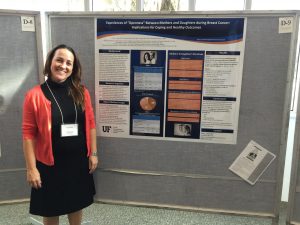Research and Insights: Overcoming Obstacles in Family Discussions About Health Care
Effective communication between healthcare workers and patients is critical to shaping risk-reducing practices and coping with rigorous treatment for life-threatening diseases. But communication between family members can be as important in dealing with medical issues. For example, studies show that conversations about risk-reducing breast cancer information between mothers and daughters can influence a daughter’s habits and even carry the advice into adulthood.
But these conversations can be difficult for both those offering comfort and advice and those receiving it. Daughters can find it distressing to talk about breast cancer risk, especially if there is a family history, and it can be challenging for mothers to navigate these conversations.
Breast Cancer Communication

Carla L. Fisher, University of Florida College of Journalism and Communications (UFCJC) Advertising Associate Professor and a member of the UF Health Cancer Center, and colleagues explored the use of social media to disseminate information to help mothers facilitate the discussion of environmental risks of breast cancer with their family members, particularly daughters.
The team used a best practice for disseminating research to the public by creating a partnership between scientists within the National Cancer Institute- funded Breast Cancer and Environmental Research Program and a community stakeholder group known as “mommy bloggers,” a network of about four million mothers who are a public source for parenting and health advice. They created a social media intervention with bloggers disseminating an evidence-based infographic integrated into a blog post about four steps mothers could take with their daughters to reduce cancer risk. The intervention enhanced mothers’ perceptions about risk, promoted mother-daughter communication, and increased their intentions to adopt healthy habits.
Fisher and colleagues also interviewed bloggers and readers to identify message strategies that promote mother-daughter communication and are culturally targeted. They identified four approaches to message design that could help facilitate mother–daughter conversations about cancer risk and lifestyle habits. Two action-oriented message approaches included strategies to help mothers get the conversation started and keep the conversation going. Two additional approaches included strategies that focus on lifespan factors to personalize the message by using age-appropriate language and visuals as well as focusing on the daughters’ developmentally specific lifestyle behavior. They also identified five cross-cultural message design strategies to reach women across cultures to promote healthy behavior changes:
- Incorporate diverse images
- Provide more information specific to environmental and cultural risk
- Heighten the message of “it’s a family affair”
- Make behavioral changes feasible
- Use less text and more visuals
Sexual and Reproductive Health
Parents have a long history of struggling with sharing “the facts of life” with their children. This discomfort with talking about sex among families, and specifically with teens, is an international phenomenon.

UFJCJ Public Relations and College of Medicine Division of Hematology & Oncology Professor Carma L. Bylund worked with a group of current and former Ph.D. students led by Michaela D. Mullis to review previous research of parents discussing adolescent sexual health with their children, spanning five continents and 19 different countries. Co-authors included Amanda Kastrinos, Easton Wollney, and Greenberry Taylor. They identified three types of communication barriers to effective communication reported by parents and/or children: personal, communal and cultural. These hurdles make informing children of appropriate sexual precautions and preventive measures challenging.
For example, a parent’s own negative sexual experience or lack of sexual health education is a personal obstacle to communicating effectively with a child. Parents feel like they aren’t a credible source, or their experience may sour their child’s perspective.
In terms of communal challenges, peer pressure and the influence of friends can make it difficult for a parent to have a frank conversation about sex. With all the noise of classmates, social media and stereotypes, children are already getting sexual information from other sources. It can be difficult to break through these influences to better inform adolescents.
Finally, in some cultures, having a dialogue about sex is taboo especially in countries with strict gender roles. It would be uncomfortable or inappropriate for parents with some strong religious beliefs to discuss sex, even with their children.
But parents play a critical role in educating their children about sexual health. They need to have “the talk.” So, parents need a little guidance on how best to bridge the gap. Resources and guidance for parents on how to establish a dialogue while respecting children’s autonomy and cultural context would go a long way.
Posted: February 19, 2021
Category: College News
Tagged as: cancer communication, Sexual and Reproductive Health


